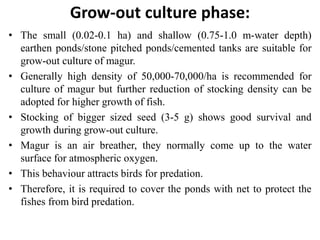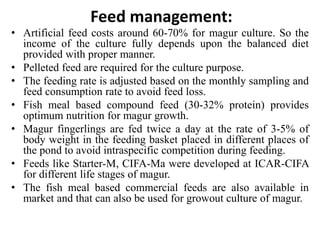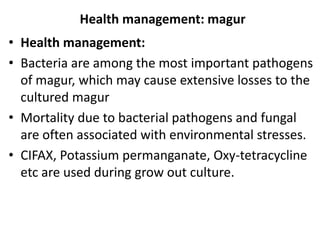Magur culture
- 1. Magur Culture By: B. Bhaskar Fisheries Field Officer, Mahabubabad, Dept, of Fisheries, TS, India ICAR-CIFA
- 2. Pond construction and preparation: for magur Culture • For effective management, the grow-out culture ponds should be of 0.02 – 0.1 ha. • Pond bund should have a suitable slope of 1:2-1:3. • The water depth may be maintained at 0.75-1 m. • Height of the dyke from the water level should be at least 100cm. • Water holding capacity of pond bottom soil should be checked out. • During rainy season magur used to crawl out of the pond. • So that during construction of pond the dyke should be made in such a way that they can't escape out. • Unwanted weeds should be removed from the newly excavated pond. • Perineal pond should be cleared from predatory fishes and unwanted aquatic plants. • Mahua oil cake can be applied @ 2500 kg/ha/m depth or bleaching powder @ 350 kg/ha for killing of predatory fishes and their eggs. • Liming depends on the pH of soil and water, where 200-250 kg/ha of agricultural lime is applied when the soil pH is above 6.0.
- 3. Grow-out culture phase: • The small (0.02-0.1 ha) and shallow (0.75-1.0 m-water depth) earthen ponds/stone pitched ponds/cemented tanks are suitable for grow-out culture of magur. • Generally high density of 50,000-70,000/ha is recommended for culture of magur but further reduction of stocking density can be adopted for higher growth of fish. • Stocking of bigger sized seed (3-5 g) shows good survival and growth during grow-out culture. • Magur is an air breather, they normally come up to the water surface for atmospheric oxygen. • This behaviour attracts birds for predation. • Therefore, it is required to cover the ponds with net to protect the fishes from bird predation.
- 4. Feed management: • Artificial feed costs around 60-70% for magur culture. So the income of the culture fully depends upon the balanced diet provided with proper manner. • Pelleted feed are required for the culture purpose. • The feeding rate is adjusted based on the monthly sampling and feed consumption rate to avoid feed loss. • Fish meal based compound feed (30-32% protein) provides optimum nutrition for magur growth. • Magur fingerlings are fed twice a day at the rate of 3-5% of body weight in the feeding basket placed in different places of the pond to avoid intraspecific competition during feeding. • Feeds like Starter-M, CIFA-Ma were developed at ICAR-CIFA for different life stages of magur. • The fish meal based commercial feeds are also available in market and that can also be used for growout culture of magur.
- 5. Health management: magur • Health management: • Bacteria are among the most important pathogens of magur, which may cause extensive losses to the cultured magur • Mortality due to bacterial pathogens and fungal are often associated with environmental stresses. • CIFAX, Potassium permanganate, Oxy-tetracycline etc are used during grow out culture.
- 6. Harvesting • Harvesting • Magur attain a marketable size of 100-150 g during the culture period of 10-12 months. • Harvesting is done by complete dewatering and picking them manually from the culture ponds. • Productions up to 2-3 tonnes/ha can be achieved in 10-12 months of culture period.





